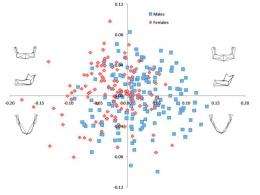November 22, 2011 report
Shift in ancient diet may explain modern orthodontic problems

(PhysOrg.com) -- Many a parent has lamented the crowding of their children’s teeth indicating impending orthodontia bills, but few no doubt have wondered quite as deeply as Noreen von Cramon-Taubadel, an anthropologist from the U.K., on why this seems to be such a common malady for modern people. After some digging, as she explains in her paper published in the Proceedings of the National Academy of Sciences, it might all be due to humans long ago moving from being primarily hunter-gatherers to farmers or more aptly, to societies that eat the crops that farmers produce.
It all comes down, von Cramon-Taubadel says, to the fact that farmed food requires less work in chewing, resulting in less jaw muscle, which over time means shorter jaws. But alas, neither the size nor number of teeth has changed over the same period of time resulting in overcrowding.
von Cramon-Taubadel came to this conclusion after studying skull and associated jaw specimens from eleven different early human populations stored in museums around the world. Of those eleven, five were representative of primarily hunter-gatherer type people’s, while the other six groups primarily relied on food obtained from farming. In her studies, she found that hunter-gatherer groups on the whole tended to have longer jawbones than did those that had resorted to depending on farmed foods. The thinking is, she says, that longer jawbones work better in dealing with hard to chew food, such as meat and some wild vegetation.
The shift from hunting-gathering to farming happened in many areas of the world some 10,000 years ago, and is widely accepted to be one of the main stepping stones to civilization. Many scientists over the years have theorized that the move to farming likely led to shorter jaws, but this is apparently the first time anyone’s thought to actually test the theory.
Realizing that the shorter jaws she’d found in her study of museum specimens could have come about for other reasons, von Cramon-Taubadel next began looking for other ways the specimens could have been correlated, i.e. geography, genetics or weather patterns and could find none. The only thing she could find in common among the groups was the way they obtained their food. Thus, she concludes that it seems reasonable to deduce that or modern dental crowding is likely the result of our ancestors move to farming and the foods we have relied on since then.
More information: Global human mandibular variation reflects differences in agricultural and hunter-gatherer subsistence strategies, PNAS, Published online before print November 21, 2011, doi: 10.1073/pnas.1113050108
Abstract
Variation in the masticatory behavior of hunter-gatherer and agricultural populations is hypothesized to be one of the major forces affecting the form of the human mandible. However, this has yet to be analyzed at a global level. Here, the relationship between global mandibular shape variation and subsistence economy is tested, while controlling for the potentially confounding effects of shared population history, geography, and climate. The results demonstrate that the mandible, in contrast to the cranium, significantly reflects subsistence strategy rather than neutral genetic patterns, with hunter-gatherers having consistently longer and narrower mandibles than agriculturalists. These results support notions that a decrease in masticatory stress among agriculturalists causes the mandible to grow and develop differently. This developmental argument also explains why there is often a mismatch between the size of the lower face and the dentition, which, in turn, leads to increased prevalence of dental crowding and malocclusions in modern postindustrial populations. Therefore, these results have important implications for our understanding of human masticatory adaptation.
Journal information: Proceedings of the National Academy of Sciences
© 2011 PhysOrg.com
















